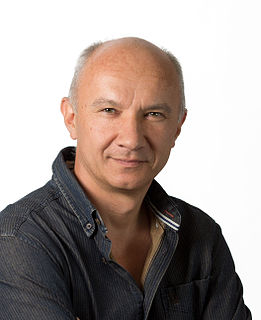Related Research Articles
A computation is any type of calculation includes both arithmetical and non-arithmetical steps and which follows a well-defined model.
Quantum computing is the use of quantum phenomena such as superposition and entanglement to perform computation. Computers that perform quantum computations are known as quantum computers. Quantum computers are believed to be able to solve certain computational problems, such as integer factorization, substantially faster than classical computers. The study of quantum computing is a subfield of quantum information science.

Computational physics is the study and implementation of numerical analysis to solve problems in physics for which a quantitative theory already exists. Historically, computational physics was the first application of modern computers in science, and is now a subset of computational science.
Hypercomputation or super-Turing computation refers to models of computation that can provide outputs that are not Turing-computable. For example, a machine that could solve the halting problem would be a hypercomputer; so too would one that can correctly evaluate every statement in Peano arithmetic.
Benjamin "Ben" Schumacher is an American theoretical physicist, working mostly in the field of quantum information theory.
Digital physics is a speculative idea that the universe can be conceived of as a vast, digital computation device, or as the output of a deterministic or probabilistic computer program. The hypothesis that the universe is a digital computer was proposed by Konrad Zuse in his book Rechnender Raum. The term digital physics was employed by Edward Fredkin in 1978, who later came to prefer the term digital philosophy. Digital physics suggests that there exists, at least in principle, a program for a universal computer that computes the evolution of the universe. The computer could be, for example, a huge cellular automaton.
Computational science, also known as scientific computing or scientific computation (SC), is a rapidly growing field that uses advanced computing capabilities to understand and solve complex problems. It is an area of science which spans many disciplines, but at its core, it involves the development of models and simulations to understand natural systems.

Artur Konrad Ekert FRS is a Polish-British professor of quantum physics at the Mathematical Institute, University of Oxford, professorial fellow in quantum physics and cryptography at Merton College, Oxford, Lee Kong Chian Centennial Professor at the National University of Singapore and the founding director of the Centre for Quantum Technologies (CQT). His research interests extend over most aspects of information processing in quantum-mechanical systems, with a focus on quantum communication and quantum computation. He is best known as one of the pioneers of quantum cryptography.
Reversible computing is a model of computation where the computational process to some extent is time-reversible. In a model of computation that uses deterministic transitions from one state of the abstract machine to another, a necessary condition for reversibility is that the relation of the mapping from states to their successors must be one-to-one. Reversible computing is a form of unconventional computing.
Bremermann's limit, named after Hans-Joachim Bremermann, is a limit on the maximum rate of computation that can be achieved in a self-contained system in the material universe. It is derived from Einstein's mass-energy equivalency and the Heisenberg uncertainty principle, and is c2/h ≈ 1.36 × 1050 bits per second per kilogram. This value is important when designing cryptographic algorithms, as it can be used to determine the minimum size of encryption keys or hash values required to create an algorithm that could never be cracked by a brute-force search.
Farid F. Abraham is an American scientist.
The limits of computation are governed by a number of different factors. In particular, there are several physical and practical limits to the amount of computation or data storage that can be performed with a given amount of mass, volume, or energy.
Landauer's principle is a physical principle pertaining to the lower theoretical limit of energy consumption of computation. It holds that "any logically irreversible manipulation of information, such as the erasure of a bit or the merging of two computation paths, must be accompanied by a corresponding entropy increase in non-information-bearing degrees of freedom of the information-processing apparatus or its environment".
The Margolus–Levitin theorem, named for Norman Margolus and Lev B. Levitin, gives a fundamental limit on quantum computation (strictly speaking on all forms on computation). The processing rate cannot be higher than 6 × 1033 operations per second per joule of energy. Or stating the bound for one bit:
A quantum Turing machine (QTM) or universal quantum computer is an abstract machine used to model the effects of a quantum computer. It provides a simple model that captures all of the power of quantum computation—that is, any quantum algorithm can be expressed formally as a particular quantum Turing machine. However, the computationally equivalent quantum circuit is a more common model.
John Myrick Dawson was an American computational physicist and the father of plasma-based acceleration techniques. Dawson earned his degrees in physics from the University of Maryland, College Park: a B.S. in 1952 and Ph.D. in 1957. His thesis "Distortion of Atoms and Molecules in Dense Media" was prepared under the guidance of Zaka Slawsky.
MADNESS is a high-level software environment for the solution of integral and differential equations in many dimensions using adaptive and fast harmonic analysis methods with guaranteed precision based on multiresolution analysis and separated representations .
Francis Harvey Harlow was an American theoretical physicist known for his work in the field of fluid dynamics. He was a researcher at Los Alamos National Laboratory, Los Alamos, New Mexico. Harlow is credited with establishing the science of computational fluid dynamics (CFD) as an important discipline.
Cristopher David Moore, known as Cris Moore, is an American computer scientist, mathematician, and physicist. He is resident faculty at the Santa Fe Institute, and was formerly a full professor at the University of New Mexico.
References
Lloyd, S., 2000, Ultimate physical limits of computation, Nature, 406:1047-1054. Aaronson, Scott J. (2004). Limits on Efficient Computation in the Physical World (Ph.D.). University of California, Berkeley. arXiv: quant-ph/0412143 . Bibcode:2004PhDT.......159A.